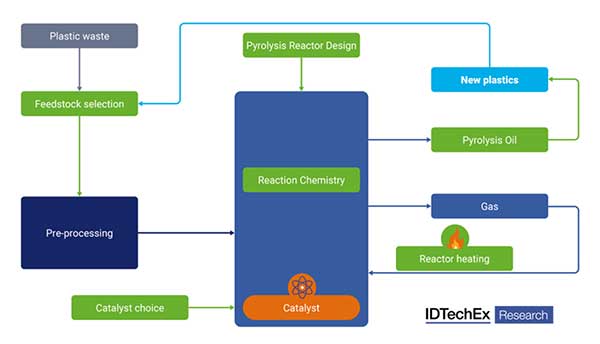By James Kennedy
The mounting global plastic waste crisis has compelled scientists and engineers to seek novel solutions.
Among the various technologies being explored, the pyrolysis of plastic waste has emerged as a significant contender. This process involves breaking down plastics at high temperatures in the absence of oxygen to produce fuels and other valuable products.
While the technological advances in pyrolysis are promising, they must be weighed against broader environmental, economic, and technical concerns. IDTechEx has identified that since 2021 the global input capacity for pyrolysis plants has increased by over 60%. With pyrolysis being the largest technology by input capacity in the chemical recycling space, its future is key for the industry as a whole.
The IDTechEx report, “Chemical Recycling and Dissolution of Plastics 2024-2034: Technologies, Players, Markets, Forecasts”, explores pyrolysis and the entire advanced plastic recycling market.
Technological advancements in plastic pyrolysis
Recent technological advancements have improved the efficiency and output quality of pyrolysis. Innovations include better catalysts and increased yield, as well as more sophisticated reactor designs. These improvements have made it possible to process a wider variety of plastic wastes, including previously non-recyclable plastics such as multilayer plastic films.
Moreover, continuous-feed systems have been developed to replace batch processes, leading to improvements in scalability and operational efficiency. These systems can handle larger volumes of plastic waste, reducing the downtime associated with batch processing and potentially lowering operational costs.

Environmental impact raises tough questions for pyrolysis
Despite these advancements, environmental concerns persist. The pyrolysis process itself is energy-intensive, often requiring a substantial amount of heat, which must be generated from external sources. This raises questions about the technology’s overall carbon footprint, especially if the energy used is derived from fossil fuels.
Moreover, the byproducts of pyrolysis include gases and residues that can be hazardous if not properly managed. For example, the process can release volatile organic compounds (VOCs) and other pollutants that pose health risks to humans and animals alike. Effective capturing and treatment of these emissions are crucial, but they add to the complexity and cost of the technology.
Another environmental challenge is feedstock contamination. Plastic waste often contains additives and other contaminants that can complicate the pyrolysis process or degrade the output quality. Advanced sorting and cleaning processes can mitigate these effects but require additional investments in waste management technologies and infrastructure.
New regulatory challenges pose a threat to the continued growth of pyrolysis for plastic waste
Regulatory hurdles are another significant challenge. Pyrolysis plants must meet stringent environmental regulations to operate, which can vary widely between regions and complicate compliance efforts. There have been many recent moves in legislation on chemical recycling. Pyrolysis has come under key scrutiny by lawmakers, notably in the US, as to whether it should be classified as recycling. As of May 2024, 9 US states have introduced bills restricting chemical recycling, and Maine has passed a law restricting it. These bills are primarily focused on pyrolysis and gasification technologies, but some also target depolymerization.
This has been motivated by the fact that while the yields of pyrolysis oil are relatively high, usually around 70-80%, by the time this oil is returned to new plastic, the yield of new plastic to original plastic is much lower. This puts into question whether this technology should be strictly considered as recycling and whether the material can count towards recycled content targets. Additionally, as an energy-intensive and highly CO2-emitting process, many believe that alternative recycling methods would be a preferable choice and that pyrolysis may need to be limited to control environmental impact. This comes alongside 24 US states passing bills supporting chemical recycling technologies. Overall, the legislative picture for pyrolysis is mixed, but if more restrictive bills are passed, this could significantly disrupt investment in this technology going forward.
Chemical recycling market forecast
For further information on this market, including discussion on players, an analysis of market trends, and a 10-year market forecast, see the market report, “Chemical Recycling and Dissolution of Plastics 2024-2034: Technologies, Players, Markets, Forecasts”. The report also contains a comprehensive summary of technology providers, a complete list of operational plants and projects, and an analysis of the latest R&D and technology trends with a commercial impact.
For more information on this report, including downloadable sample pages, please visit www.IDTechEx.com/ChemicalRecycling.
For the full portfolio of sustainability market research available from IDTechEx, please see www.IDTechEx.com/Research/Sustainability.
The author is a Technology Analyst at IDTechEx




















